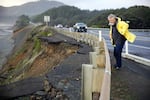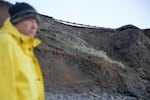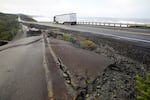
Onno Husing, the planning director for Lincoln County, can stand on Highway 101 and watch bits of tarmac crumble into the ocean, 80 feet below, “It’d be pretty hard to stand here and look at what we’re looking at, and not be concerned,” he said.
Kristian Foden-Vencil / OPB
Editor’s note: This story is the first in a two-part series looking at the challenges of erosion and development on the Oregon coast. Tomorrow we’ll look at the lengths some communities seek to go to protect coastal homes.
A couple of miles north of Newport, Highway 101 runs above Moolack Beach, affording breath-taking views of the Pacific.
The highway is straight and relatively flat in this spot, so not a big engineering challenge. But the planning director for Lincoln County, Onno Husing, can stand here and watch bits of tarmac crumble into the ocean, 80 feet below.
“It’d be pretty hard to stand here and look at what we’re looking at, and not be concerned,” he said recently.
On the beach, waves roll in constantly, in the process steadily eroding the land supporting the highway. Thousands of people drive this stretch to get to work everyday, or because they live in Lincoln City or Tillamook. Highway 101 is a lifeline, linking communities across the coast.
“You don’t need to be an engineer to understand that the highway is threatened,” Husing said.
Moolack Beach is just one of dozens of problem spots along Highway 101. Husing and other experts say the road needs reinforcing, especially with what’s known in the engineering world as rip rap — placing large rocks at the base of the road to break-up wave energy and reduce ocean erosion.

Standing on Moolack Beach, Lincoln City planning director Onno Husing can see how the ocean is undercutting Highway 101. “You don’t need to be an engineer to understand that the highway is threatened," he said.
Kristian Foden-Vencil / OPB
But the Oregon Department of Transportation isn’t allowed to use rip rap along Highway 101, because back in 1977, the Oregon Land Conservation and Development Commission adopted Goal 18 as part of Oregon’s comprehensive land use planning effort. That rule blocked the use of rip rap for any new development, unless there’s an exception.
This was near the beginning of the environmental movement. Goal 18 was a way of ensuring Oregon’s coast didn’t come to resemble California — with hundreds of miles of oceanfront rip rapped against erosion.
Many people don’t like the way rip rap looks. And it can cause waves to scour the beach of sand. That means that eventually, there’s no more beach left for the public to enjoy.
But developers are an imaginative bunch. As soon as Goal 18 was adopted, they started pushing back against the definition of “development” in the state rules. In 1984, the state officially defined the term to include “…houses, commercial and industrial buildings, and vacant subdivision lots which are physically improved through construction of streets and provision of utilities.”
Meg Reed, a coastal specialist with the Oregon Land Conservation and Development Commission, said the new definition has gaps: “That definition does not include public infrastructure,” she said. “Roads, sewer lines, campgrounds, lighthouses: it doesn’t include any of that in the definition.”
In other words, using rip rap to protect Highway 101 hasn’t been allowed for 45 years. And that’s a challenge for a road that runs right up against the coast for many of its 363 miles.
Highway 101 is the backbone of Oregon’s coastal transportation system. It officially became US Highway 101 back in 1926, as cars were becoming more common. Squeezed between the ocean and the steep slopes of the Coastal Range, the highway has never been as important to interstate commerce as, say, Interstate 5. But it is key to linking coastal communities together.
It’s also a testament to engineers that Highway 101 has lasted close to 100 years with relatively few upgrades.

Stretches of Highway 101 like this have had to be abandoned and a new road built.
Kristian Foden-Vencil / OPB
But in 2002, the Oregon Department of Transportation identified 25 sites of concern. They included areas of the highway being undercut by erosion, or in danger from landslides, floods, sea level rise and storm surges. As coastal residents know, it’s not uncommon for stretches of 101 to be closed for days, weeks or even more. In some spots, closures mean travelers have to drive all the way into the Willamette Valley to reach their destination.
So in response, state leaders decided it was time to rewrite Goal 18 so the highway can be repaired. Suggestions were put forward by developers and environmentalists. Public meetings were held. Reed said in the end it became very controversial.
“It got pretty far until it came to our commission for its final hearings, and then there was a big public outcry from many different sides,” Reed said.
In the end, the state decided not to touch Goal 18, so Highway 101 remains unreinforced.
Fast forward another 20 years, and those 25 areas of concern identified by the transportation department are now more like areas of alarm.
The Oregon transportation department has bolted rulers across some cracks to check for movement. They’re also digging wells to monitor the groundwater. A change in groundwater levels can predict or even cause a landslide.
The problem is so bad the state has decided to try to re-write Goal 18 again. But this time, they’re limiting themselves to one small tweak.
“We’re going to put in a specific exception for public roads along the oceanfront that were developed as of January 1, 1977,” Reed said.
Geoff Crook with the state transportation department says Highway 101 definitely needs work. “ODOT very much welcomes any change to the current Goal 18 exception process,” he said.
But rewriting Goal 18 worries environmental groups.
Briana Goodwin with the Surfrider Foundation said advocates understand Highway 101 needs to be safe. But they’re worried changing Goal 18 might allow more development and add to the scouring of beaches.
“We know that developers are waiting to see what happens with Highway 101,” Goodwin said. “And we do expect that if the law is loosened up at all or any loopholes are opened, that there will be a lot more applications for Goal 18 exceptions.”
Meanwhile, bits of Highway 101 continue crumbling into the sea. Lincoln County planner Onno Husing said if the road gave-out underneath his feet, emergency rules would allow diggers on site within hours to shove rip rap into place and reopen the highway.
“ODOT would be in here on an emergency basis,” Husing said. “It’d make your head spin. They’ll come in here and they’ll fix that.”
He said local authorities think Highway 101 is just too important to fall into disrepair. They also think there are better ways of maintaining an important road than waiting for emergency repairs.
The Oregon Department of Land Conservation and Development has put together an advisory committee to come up with draft rule language. The committee is made up of small businesses representatives, environmentalists, someone from the Oregon Department of Transportation, a Tillamook County public works representative, a Coos County commissioner and others.
Their language will be finalized by staff and legal counsel at the state. A seven-member commission, appointed by the governor and confirmed by the Oregon Senate, will then have a series of public hearings this summer to talk about the proposed rule.
The commission is expected to vote on the issue in July.
